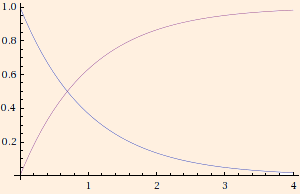
| (prev) | (top) | (next) |
Conservation of energy gives Kirchhoff's loop rule: Σclosed loop ΔV = 0.
(q - C V) = - R C dq / dt
dq / (q - C V) = - dt / (R C)
ln (q - C V) = a - t / (R C)
q(t) = C V + b e - t / (R C)
Electrical Circuits
ΔVeq = ΔV1 + ΔV2
becomes
Req = R1 + R2
Two resistors in parallel have the same voltage drop so with Ohm's law,
Ieq = I1 + I2
becomes
1/ Req = 1 / R1 + 1 / R2
V - q / C - I R = 0
If q(0) = 0 and V > 0 (charging),
q(t) = C V (1 - e - t / (R C))
If q(0) = Q and V = 0 (discharging),
q(t) = Q e - t / (R C)
The time constant is τ ≡ R * C.
This plot shows the current (dq/dt) charging the capacitor in blue and the current through the resistor in red:

Note that as the capacitor charges, the current shifts from it to the resistor. When the capacitor is fully charged, it is effectively open
and all of the current flows through the resistor.
| (prev) | (top) | (next) |
©2012, Kenneth R. Koehler. All Rights Reserved. This document may be freely reproduced provided that this copyright notice is included.
Please send comments or suggestions to the author.